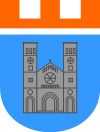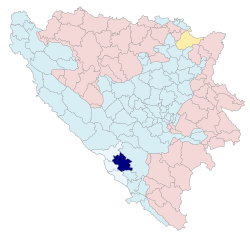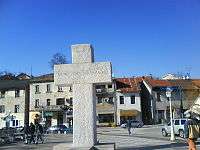Široki Brijeg
Široki Brijeg (![]()
Široki Brijeg Широки Бријег | |
|---|---|
| Grad Široki Brijeg City of Široki Brijeg | |
The City of Široki Brijeg panorama | |
 Flag  Coat of arms | |
 Location of Široki Brijeg in Bosnia and Herzegovina | |
 Široki Brijeg Location of Široki Brijeg in Bosnia and Herzegovina | |
| Coordinates: 43°22′59.31″N 17°35′33.86″E | |
| Country | Bosnia and Herzegovina |
| Entity | Federation of Bosnia and Herzegovina |
| Canton | West Herzegovina |
| Government | |
| • Mayor | Miro Kraljević (HDZ BiH) |
| Area | |
| • Total | 387.6 km2 (149.7 sq mi) |
| • Land | 387.6 km2 (149.7 sq mi) |
| • Water | 0 km2 (0 sq mi) |
| Elevation | 312 m (1,024 ft) |
| Population (2013) | |
| • Total | 29,809 |
| • Density | 77/km2 (200/sq mi) |
| Time zone | UTC+1 (CET) |
| • Summer (DST) | UTC+2 (CEST) |
| Post code | 88220 |
| Area code | +387 039 |
| Website | www |
Name
Široki Brijeg means "wide hill". It is sometimes referred to as Široki Brig or simply Široki ("wide"). Until 1996, the town was officially called Lištica after the river that runs through it.
Geography
The town is 20–25 km (12–16 mi) from Mostar,[1][2] 29 km (18 mi) from Međugorje,[3] and 88 km (55 mi) from the Adriatic coast (Ploče).[4]
The Široki Brijeg Municipality today numbers around 30,000 people, and the town itself about 13,000. The area of the municipality amounts to 1,168 ha (2,886 acres; 5 sq mi). The center of town is at 270 m (886 ft) above sea level, while its area is known as "lower Herzegovina". Almost the entire northern part of the municipality itself, however, belongs to "high Herzegovina", the highest point being the Bile stine ("White Rocks") near Donji Crnač.
Climate
Široki Brijeg has mild submediterranean-mountain climate. Winters are chilly and often very cold. Summers are warm.
Terrain
The wider area of the municipality of Široki Brijeg is located on the characteristic, complex structural forms known as the "high karst zone" in geologic terms. The basic characteristic is the rocky limestone relief in various karst forms (sinks, caves, sinkholes, karst fields, etc.), as well as deeply cut valleys with occasional torrents flows. The Široki Brijeg area is located on the direction of tectonic units Rakitno-Hrgud and spreads over Rakitno, Vardi mountains, Mostarsko Blato, Rotimlje and Hrgud to Trebišnjica in the southeast. The area is made-up of up late Jurassic sediments, followed by Cretaceous and Paleogene age layers, then Neogene and Quaternary deposits. Highlights are early Cretaceous dun, well stratified limestone and dolomites. Late Cretaceous deposits, cenoman-turon, are represented by white and pink, massive limestone with the shoot. In Paleogenic layers function Liburnijska and alveolinic-nummulitic limestones, then eocenic flysch, which is represented by marl, sandstone, calcarenite and conglomerates.
Neogenic layers are built of marl, sandy clay, sandstone and conglomerates, and can be found in the vicinity of Grabovo Drage and Mostarsko Blato. Quaternary banks of pebbles, sand and water karst saturated found on almost all rocky fields and drifts along the river beds. Between the lower mountain Vardi, Gvozd, Rujan and Trtle (altitude 600-900m) is a karstic depression Kočerinsko, Trnsko, Mokarsko and Ruževo field and Mostar Blato (altitude of 220-300m). Široki Brijeg area belongs to typical bauxite courts Lokve Black - Kidačke Njive, Resnica - deposit and Uzarići - Knešpolje. This area was devastated shoot landfills and tailings, and rehabilitation requirements.
Waters
The water from the municipality of Široki Brijeg belong to the basin of the Neretva river. The main surface currents towards Mostar Blato the ticket with Ugrovača, Mokašnica, Crnašnica and Žvatić. The river belongs Lištica of surface waters Čabulje, who bujični aquifer Brinje collected from Ladin and Dobrinja. Brinje whose rudiments north of Bogodola, below kote Kulic (1199) runs to the west and on their way to Lištica receives at Prskalo stream Ladin, and 2.5 kilometers below, the stream of water Dobrinski. These streams buy all surface waters during the period of abundant precipitation and dissolution of snow on the south-western parts of the mountain Čabulje.
Surface waters come to Rakitno field are being dried by water points, Jelica, Zmijinac and during major precipitation formed a periodic watercourse Ugrovača that going deeply carved canyon Brin, receiving side stream, and in the village of Trn, Kočerin water fields, and on the road to Blato Mostarskog, in Siroki Brijeg center connects with the river Lištica.
History
Ancient period
The ruins from the Illyrian period confirm that the area of Široki Brijeg had a large population in pre-historic times. The evidence can be seen on the hill Gradina on the frontier of Mokro and Čerigaj. There is also evidence on the walls of the forts where they had been in past. During the ancient period there was plenty of life in that region. From the Roman period there are remains of a fort (refugium) in the village of Biograci and a basilica in Mokro; there are remain of the forts and roads there.
Middle ages
Emperor Constantine VII Porphyrogennetos mentions that Mokriskik was in that area . The basilica in Mokri was built and destroyed several times in the Middle Ages and it was used for its purpose. In her neighbourhood is nekrepola with stećak,which are present elsewhere. There number and size indicate that this region was (from 12th till 15th century) has been very populated and rich. From that period on Kočerin was kept the longest tablet on stećak written with Bosnian Cyrillic, known as Kočerinska ploča („Kočerin tablet"). The residues of middle-age fort can be found in the Bork, close to the source of river Lištica.
Ottoman rule
After the Turkish conquest in the middle of 15th century the population was mainly rural and in the mountains. Until the middle of 19th century, Herzegovina was cut off from social, cultural and political events in other European countries.
Austria-Hungary
World War II and Yugoslavia
During the Second World War the Ustaše held the city together with Italian troops. During their presence, the Italians built several forts for observation of the city.
Like some cities in West Herzegovina, Široki Brijeg was labeled as a pro-Ustaše and a pro-fascisct region. It was therefore demonized by the officials of Yugoslavia and was renamed Lištica (by the name of the river) instead of Široki Brijeg (Wide Hill). Investment in the city was also very poor. A number of people emigrated to Zagreb and Dalmatia, as well as to Germany as gastarbeiters.
In 1985, the local Communist Party built a monument to the Yugoslav Partisans in the centre of the town with Partisans ostensibly reburied beneath it. On 3 May 2013 the monument was removed to explore the mass grave, revealing the remains of 95 people.[5] The remains were characteristic of those killed by the Partisans themselves, with bodies being tied up with wire and some German dog tags being recovered.[6]
Settlements
- Biograci
- Brig
- Buhovo
- Crne Lokve
- Čerigaj
- Dobrič
- Dobrkovići
- Doci
- Donja Britvica
- Donji Crnač
- Donji Gradac
- Dužice
- Gornja Britvica
- Gornji Crnač
- Gornji Mamići
- Grabova Draga
- Izbično
- Jare
- Knešpolje
- Kočerin
- Lise
- Ljubotići
- Ljuti Dolac
- Mokro
- Oklaji
- Podvranić
- Potkraj
- Privalj
- Rasno
- Rujan
- Široki Brijeg
- Trn
- Turčinovići
- Uzarići
Economy
Agriculture
Agricultural production in the municipality of Široki Brijeg is mostly reduced to the production for their own use on yards and a minor part of the arable land. It is the production of agricultural products for the market is very small compared to the alternatives, and refers primarily to the production of wine, a little bit in the production of vegetables and flowers, very little in the livestock and milk production.
This resulted in a large percentage of agricultural land is not used- according to latest statistics - even 60% that could be used for agricultural land is not processed.
The lack of clear government strategy and orientation towards the launching and development of agricultural production is also very important feature of the present situation in agriculture .
Prior to the war
Unlike twenty years ago, is now in agricultural production there is no fundamental cultural production, production that would be meaningful and possible in a larger area of the municipality. For many years it was tobacco. Together with the war has fallen down and the existing state system and thus the former system of organization of agricultural production. In the entire period since then until today, the new system was established.
It is the whole country, especially the area where the municipality brought nekontroliranom import all kinds of things. So the majority of agricultural products has become cheaper to import than produce.
The result has already been mentioned drastically reducing obrađivanih area, reducing the number of cattle and even up to five times, the entire reduction in volume of agricultural production. Finally it came to life the feeling that it is impossible to engage in agricultural production as the production activity of which can be live or something and make money.
After the war
The municipality's overall economic performance is stronger than that of the surrounding municipalities - primarily in the Entrepreneurial Sector, and the time orientation and working-age population by non-sector higher. Therefore, the percentage of uncultivated land is the largest in the municipality in comparison to the surrounding ones- 60% (Posušje 59%, 49% Ljubuški and Grude 47%). The number of residents who are engaged solely in agriculture is relatively smallest in Siroki Brijeg.
Industry
In the area of industrial production in the municipality are significantly represented meat industry and metal industry, and to a smaller production of footwear, manufacture of construction products and stone processing, production of insulation materials, graphic activity, etc.
Official statistics, which regularly publishes the Federal Bureau of Statistics tracked the movement of industrial production at the level of the Federation and cantons, so that these (official) data for the municipality does not have. However, the basic features of industrial production in this region in the West would be essentially similar and reflect the movement of industrial production for the municipality of Siroki Brijeg.
In the period 2004/2005 the recorded slight growth of the index of industrial production (101.3). When the production of metals and production of metal products recorded a significant growth (index 2005./2004. = 134.3 and 180.4), production of paper products (index = 110.7), while other areas of industrial production recorded a significant decrease ( such as food and beverages: Index = 80.0, mining: index = 71.4).
For further growth of industrial production are essential investments in the development of existing industrial capacity in the areas that are currently represented in the municipality and which employ a large number of workers. This primarily refers to the production of metals and metal products. These activities according to official statistics reported a continued growth during 2005 year. The establishment and construction of new or expansion of existing business and industrial zones is prerequisite for the growth of manufacturing sector, attract domestic and foreign capital and create new jobs.
Sport
Široki Brijeg has multiple national champion in many sports, including football and basketball. NK Široki Brijeg is a double champion and conqueror of BiH Cup champion five consecutive league HB, and their domestic matches played on stadium Pecara, which meets all the criteria of the UEFA-e, while Mostar in the mud works modern Sports-recreation center / training camp Musa-Karačić with the ambulance, equipped with shower, two natural and one playground with artificial grass. Basketball club, founded in 1974, still bears the name of HKK Široki and the multiple champion, as well as won multiple State Cup and most postwar BiH club titles with 10 National Championships and 9 titles Cup conquerors of Bosnia and Herzegovina.
Culture

The town is the birthplace of the football player Mario Bazina and singer Ivan Mikulić (who appeared in the Eurovision Song Contest representing Croatia in 2004). The town was also the birthplace of former Croatian defence minister Gojko Šušak, an expatriate in Canada for many years.
Demographics
1971
27,285 total
- Croats - 26,940 (98.73%)
- Serbs - 234 (0.85%)
- Muslims - 43 (0.15%)
- Yugoslavs - 12 (0.04%)
- Others - 56 (0.20%)
Notes
- Široki brijeg –city map ISBN 978-953-7360-05-4
- |EUR&carbCost=1.3&isAvoidFrontiers=false&isFavoriseAutoroute=false&isAvoidPeage=false&isAvoidVignette=false&isAvoidLNR=false&autoConso=6.8&villeConso=6&routeConso=5.6&dtmDeparture=9%2F3%2F2009&indemnite=0
- |EUR&carbCost=1.3&isAvoidFrontiers=false&isFavoriseAutoroute=false&isAvoidPeage=false&isAvoidVignette=false&isAvoidLNR=false&autoConso=6.8&villeConso=6&routeConso=5.6&dtmDeparture=9%2F3%2F2009&indemnite=0
- ABCPortal & 4 May 2013.
- HRSvijet & 6 May 2013.
References
- "U Širokom Brijegu uklonjen 'Kameni cvijet', spomenik iz komunističkog vremena". ABCPortal (in Croatian). 4 May 2013. Archived from the original on 7 May 2013. Retrieved 12 May 2013.
- "Otkrivena strogo čuvana tajna: Titov "kameni cvijet" čuvao ulaz u masovnu grobnicu s tijelima ubijenih civila i njemačkih vojnika". ABCPortal (in Croatian). 4 May 2013. Retrieved 12 May 2013.
- "'Kulturnu večer fra Didaka Buntića' u Širokom Brijegu". Ekspresno (in Croatian). 10 October 2013. Archived from the original on 18 October 2013. Retrieved 12 October 2013.
External links
| Wikimedia Commons has media related to Široki Brijeg. |
| Wikivoyage has a travel guide for Široki Brijeg. |